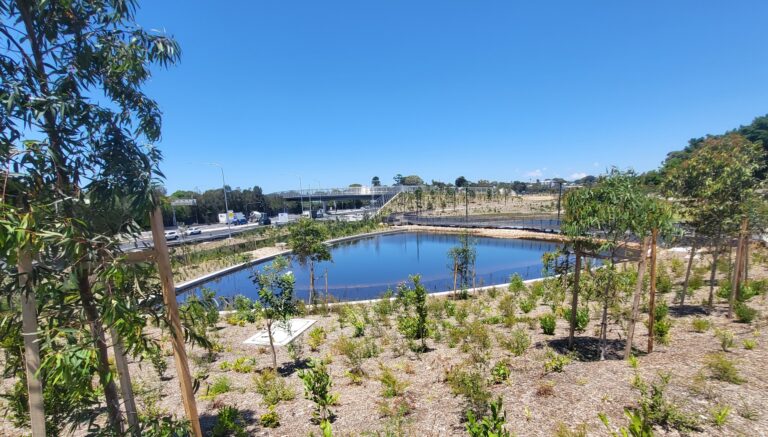
WestConn builders: Environmental Offenders
BY WENDY BACON
Westconnex builders CPB Contractors were convicted last Wednesday of breaching the NSW Protection of the Environment Operations Act in 2017—and ordered to pay nearly half a million dollars.
The NSW Land and Environment Court found that on four separate occasions, CPB caused serious harm to residents, school children, workers and EPA staff by failing to control toxic odours from untreated leachate or contaminated water pooling at the WestConnex St Peters Interchange site.
The harm included asthma attacks, chest pain and severe nausea. The four episodes that were prosecuted took places over more than 30 hours but the odours came and went for months. An EPA staff member provided evidence that it was the worst odour she had ever experienced. CPB acknowledged that it had failed to hire a suitable expert to supervise construction at the old landfill site and that had it done so, serious harm could have been prevented.
After pleading guilty, CPB Contractors were ordered to pay $445,000 in fines and costs. The company is also required to publish announcements about their convictions in the media and on their social media sites.
Inner West Independent Councillor Pauline Lockie was an active member of the WestConnex Action Group in 2017 when the offences occurred. Although her family was forced out of St Peters when their home was compulsorily acquired, she knew dozens of community members who were affected. She was one of those who spearheaded the campaign to stop the odours.
She describes the episode as a “classic example of the callous way WestConnex and its contractors treat residents during construction, and how hard it is for ordinary people to stop them doing it, even when it affects people’s health and safety.
“In this case, it took months of lobbying, complaints and media campaigning to take WestConnex and CPB from denying the issue existed to admitting that it did but downplaying it, to finally being forced by the EPA to fix it. In the meantime, people were suffering – and there was no escape.” Those people who could not escape included thousands of residents, workers and school students across several suburbs. and users of Sydney Park.
WestConnex a big winner for CPB Contractors
No company is more heavily involved in WestConnex than CPB Contractors. It has played a major role in constructing all WestConnex stages, except the mainline M4/M5 tunnel which is being built by a consortium involving Lendlease. CPB is a subsidiary of the global company CIMIC that is involved in roads and other transport projects, ports, coalmines, and other major building projects. After the initial tender failed to attract a suitable bid, NSW Roads and Maritime Services (RMS) contracted CPB to build the massive Rozelle Interchange project. When completed, it will be handed to Transurban, which already controls the rest of WestConnex. The Rozelle project is considered especially risky. No such complex spaghetti interchange has previously been built underground anywhere in the world. If CPB does not complete it on time, RMS will have to pay penalties to Transurban.
NSW’s approval of the M4/M5 project in May 2018, including the Rozelle Interchange, was very controversial. The NSW Planning approval was based on no more than a concept. There was almost no detail about tunnelling, road works or their impact. The NSW EPA advised NSW Planning that the project should not be approved because the Environmental Impact Statement (EIS) lacked sufficient detailed assessment of the project’s impacts. Despite the EPA’s advice, Planning NSW approved the project. One week earlier, the EPA had launched its prosecution of CPB Contractors.
Anti-WestConnex campaigners responded with a protest outside NSW Parliament. City of Sydney Mayor Clover Moore, then Deputy Mayor Jess Miller, three Greens MPs Mehreen Faruqi, Balmain MP Jamie Parker and Newtown MP Jenny Leong, Inner West Independent Councillor Pauline Lockie and Waverley Labor Councillor now Labor MP Marjorie O’Neill ripped up giant facsimiles of the approval to loud cheers.
CPB wasted no time in pushing ahead and according to the WestConnex website, the project is now 49% complete, although tunnelling will not begin until next year. CPB has cleared hectares of vegetation, destroyed Buruwan Park and demolished buildings while leaving residents in the dark about its actual plans. At a recent community advisory group meeting, CPB apologised for misrepresenting its reasons for destroying some trees.
CPB release maps of Rozelle Interchange
In August this year, RMS delivered bad news. It was seeking NSW approval to add a large above-ground overpass across Rozelle, This is a substantial change to the project which was promoted to the community as being an underground project. Such changes are allowed under the NSW Critical Infrastructure laws which heavily favour the RMS and developers. This overpass is part of the Western Harbour Tunnel (WHT) project, which adjoins WestConnex. A ‘substantial modification’ does require approval. After several weeks for consultation, NSW Planning is assessing the ‘modification’. If approved, its construction will function to encourage communities from Rozelle to Cammeray on the North Shore to accept the WHT as an inevitability.
Just two days after it was sentenced, CPB released the first publicly available map of its designs for the underground parts of the WestConnex Rozelle Interchange. Many residents discovered for the first time that tunnels will be less than 10 metres under their homes. Because the ‘concept design’ for the underground exchange was approved, CPB is not required to consult or seek further approval before moving forward with its plans to turn its twisted map of underground tunnels into reality.
The map also shows more major changes are on the way including extra tunnels under densely settled streets in North West Rozelle to create a cavern for a ventilation facility linked to one of four unfiltered pollution stacks planned for Rozelle.
North West Rozelle resident Brian Gorman told City Hub, ” I don’t understand how, after a thorough EIS and approval process … such a significant change in design isn’t triggering a complete new approval and a halt to construction. The complete lack of detail in the proposed design changes is worrying as we don’t know what the lines and blobs shown in the map really are. We don’t know how deep these items are or how big they actually are.” As a resident who will be living near a tunnel portal, stack and major construction, Gorman is hoping to get answers at a small information session. Anyone who lives further than 50 metres from the project is not invited to one of these sessions, even though Otus Intelligence Group satellite imagery reveals that CPB tunnelling on the M4 East and New M5 has caused movement up to 400 metres from the project.
Even if the company had a perfect record of safety, proceeding with the project without a regulatory assessment of its detailed impacts would be very risky—and CPB Contractors’ project record is poor. A NSW Parliamentary Committee into the Impacts of WestConnex received a huge amount of evidence that the health of residents living near WestConnex M4 East and New M5 projects had been damaged by unacceptable noise, dust and stress. Complaints procedures repeatedly failed leaving communities feeling that they were treated with contempt. The committee acknowledged the “severe and multiple health impacts” including “constant noise and pollution from construction and endless night works have led to mental health issues for residents as well as disrupting daily life which has had profound consequences.”
Unfortunately, a majority of the Committee including Liberal, National and Labor members voted in favour of continuing with Stage 3 of WestConnex. Only the Greens dissented.
NSW Planning and RMS acknowledged that measures to control impacts had sometimes failed. They promised to do better with Stage 3. City Hub can report that even this week, one of the main complainants in the odours case has been experiencing unbearable noise during these school holidays.
Lessons from Odours
If Rozelle, Annandale and Lilyfield residents want an insight into how CPB contractors have managed risk, they can learn a lot from the experience of St Peters residents.
After the odours began to cause distress, the WestConnex Action Group discovered that the risk of odours was barely discussed in the New M5 Environmental Impact Statement (EIS). The Land and Environment Court judgement found that a CPB technical report findings were erroneously based on average rainfall and failed to take account of what would happen in more extreme rain events.
After odours became uncontrollable, the under-resourced EPA struggled to force CPB contractors to take extra remediation and monitoring measures. CPB were eventually issued with Clean Up Notices that required it to take actions to improve leachate management.
On a normal worksite, the EPA could stop work until the problem was solved. However, as the NSW EPA itself explained to residents, a little known change to the NSW Planning Act in 2012 removed the EPA’s powers to stop work on Critical State Significant Infrastructure sites such as WestConnex.
The EPA’s lawyers submitted to the NSW Land and Environment Court that CPB knew that they could cover the leachate but chose not to do so because this would have meant stopping excavation until the water levels caused by the rain dropped. This showed, the EPA argued, that CPB could have brought a halt to the terrible odours but did not so so because stopping work would lead to “delays for the whole of the WestConnex New M Stage 2 program.” The judge found that the EPA had not demonstrated that it was “reasonable in a practical sense for (CPB) to stop work given the state significant project status of WestConnex”and that it was also in the community’s interests for the project to be completed so that the inconveniences and impacts of a large construction project ended as soon as possible.”
In this respect, the judgement comes close to finding that commercial needs trump community health needs. If asked, the distressed community would surely have preferred the sickening odours to stop, even if it meant that the project would get further behind schedule. In practical terms, it would seem that CPB preferred to risk the prosecution and fines than the costs of delay.
Although the offences were serious, CPB Contractors were fined less than one-third of the maximum fine of $1 million. Justice Pain gave them the benefit of being a “good corporate citizen” partly because they had not previously been convicted of environmental offences and partly because of their community engagement, such as support for the White Ribbon Society.
There is no mention of previous penalty notices issued to CPB Contractors or that a major CPB sub-contractor Metropolitan Demolition and Recycling Pty Ltd pleaded guilty to providing false information to the EPA to “avoid RMS fees by underreporting overloaded trucks.” This conviction related to a period when residents made many complaints to the EPA about unsafe removal of asbestos and failure to control dust. There were also repeated evacuations of the M4 East tunnel due to gas leaks and other health and safety concerns during the project’s final stages. As City Hub reported in April, these problems continued until eventually, contamination levels were so high that a young worker developed mould in his ear.
Also not mentioned was Fairfax’s major investigation into corruption allegations against Leighton Holdings, now named CIMIC, the owner of CPB (formerly Leighton Contractors) or that in December 2018, the former chief financial officer of Leighton Holdings, Peter Gregg was found guilty of falsifying the company’s accounts.
CPB promises not credible
As fresh alarm-bells ring across the Inner West, Rozelle Project director Tarnjit Chahal was quoted in the SMH as saying, “On this project, in the unlikely event that tunnelling has caused any damage, we’ll treat property owners fairly….We’re expecting virtually no damage to properties as a result of our tunnels.”
Councillor Lockie remains unconvinced. “It’s hard to believe CPB’s assurances that there’ll be ‘virtually no damage’ from the very shallow tunnelling they’re doing.”
Previous WestConnex tunnels have left behind significant damage. “Residents who’ve suffered property damage [in the past] have been fighting for months, if not years, for compensation. It’s clearly the way they work. It’s a system that fails residents at every turn,” explains Councillor Lockie.
Over in St Peters, Lendlease has already begun tunnelling at shallow depths under houses in Crown Street. Already there are reports of cracking. For the moment, WestConnex has forged ahead and will come back to complete these very shallow sections when the rest of the tunnel is completed.
Local Greens MP Jamie Parker has called a meeting of Rozelle, Lilyfield and Leichhardt residents on November 2nd.
“It defies common sense to think that you can build a spaghetti junction less than 10 metres underground and not impact people’s homes,” he says. “These tunnels are designed to be shallow to give motorists a smoother drive despite the increased risk this poses to people’s homes on the surface. When the government prioritises driving experience over the structural integrity of properties, they make it crystal clear that they work to serve tollway companies, not residents.”
Parker is calling on the NSW government to “increase the depth of this junction to reduce the risk of damage to properties, to expand the number of properties eligible for compensation and commit to installing ground movement and vibration monitoring for all homes.”
Wendy Bacon was previously the Professor of Journalism at UTS. She has campaigned against WestConnex. You can find details of Jamie Parker’s meeting here.









